
Cnidaria is a phylum under kingdom Animalia containing over 11,000 species of aquatic animals found both in fresh water and marine environments, including jellyfish, hydroids, sea anemones, corals and some of the smallest marine parasites. Their distinguishing features are a decentralized nervous system distributed throughout a gelatinous body and the presence of cnidocytes or cnidoblasts, specialized cells with ejectable flagella used mainly for envenomation and capturing prey. Their bodies consist of mesoglea, a non-living, jelly-like substance, sandwiched between two layers of epithelium that are mostly one cell thick. Cnidarians are also some of the only animals that can reproduce both sexually and asexually.

The Scyphozoa are an exclusively marine class of the phylum Cnidaria, referred to as the true jellyfish.

Box jellyfish are cnidarian invertebrates distinguished by their box-like body. Some species of box jellyfish produce potent venom delivered by contact with their tentacles. Stings from some species, including Chironex fleckeri, Carukia barnesi, Malo kingi, and a few others, are extremely painful and often fatal to humans.

The Atlantic sea nettle, also called the East Coast sea nettle in the United States, is a species of jellyfish that inhabits the Atlantic coast of the United States. Historically it was confused with several Chrysaora species, resulting in incorrect reports of C. quinquecirrha from other parts of the Atlantic and other oceans. Most recently, C. chesapeakei of estuaries on the Atlantic coast of the United States, as well as the Gulf of Mexico, was only fully recognized as separate from C. quinquecirrha in 2017. It is smaller than the Pacific sea nettle, and has more variable coloration, but is typically pale, pinkish or yellowish, often with radiating more deeply colored stripes on the exumbrella, especially near the margin.

Chironex fleckeri, commonly known as the Australian box jelly, and nicknamed the sea wasp, is a species of extremely venomous box jellyfish found in coastal waters from northern Australia and New Guinea to Indonesia, Cambodia, Malaysia and Singapore, the Philippines and Vietnam. It has been described as "the most lethal jellyfish in the world", with at least 64 known deaths in Australia from 1884 to 2021.

Pelagia noctiluca is a jellyfish in the family Pelagiidae and the only currently recognized species in the genus Pelagia. It is typically known in English as the mauve stinger, but other common names are purple-striped jelly, purple stinger, purple people eater, purple jellyfish, luminous jellyfish and night-light jellyfish. In Greek, pelagia means "(she) of the sea", from pelagos "sea, open sea"; in Latin noctiluca is the combining form of nox, "night"", and lux, "light"; thus, Pelagia noctiluca can be described as a marine organism with the ability to glow in the dark (bioluminescence). It is found worldwide in tropical and warm temperate seas, although it is suspected that records outside the North Atlantic region, which includes the Mediterranean and Gulf of Mexico, represent closely related but currently unrecognized species.
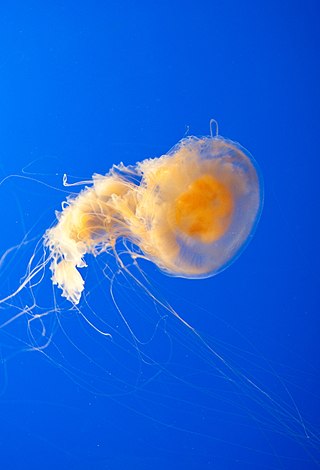
Phacellophora camtschatica, commonly known as the fried egg jellyfish or egg-yolk jellyfish, is a very large jellyfish in the family Phacellophoridae. This species can be easily identified by the yellow coloration in the center of its body which closely resembles an egg yolk, hence its common name. Some individuals can have a bell close to 60 cm (2 ft) in diameter, and most individuals have 16 clusters of up to a few dozen tentacles, each up to 6 m (20 ft) long. A smaller jellyfish, Cotylorhiza tuberculata, typically found in warmer water, particularly in the Mediterranean Sea, is also popularly called a fried egg jellyfish. Also, P. camtschatica is sometimes confused with the Lion's mane jellyfish.
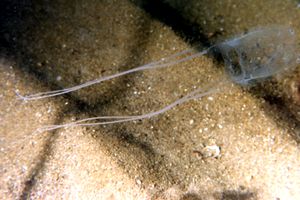
Carybdea is a genus of venomous box jellyfish within the family Carybdeidae that currently consists of a total of 8 species. This genus of jellyfish are often found in warm waters around the world in waters such as the Mediterranean Sea, the Pacific Ocean, and off the coast of Africa. Their sting can cause a range of effects depending on the species. These invertebrates will go through both sexual and asexual reproduction as they transform from a polyp to medusa. Carybdea have a box-shaped bell with four tentacles and eye-like sensory structures. There are distinct physical markings that differentiate many species within the genus. While Carybdea use their venom to act as predators, they are also preyed on by turtles and various fish. They feed on plankton, invertebrates, fish, and some crustaceans.

Chrysaora hysoscella, the compass jellyfish, is a common species of jellyfish that inhabits coastal waters in temperate regions of the northeastern Atlantic Ocean, including the North Sea and Mediterranean Sea. In the past it was also recorded in the southeastern Atlantic, including South Africa, but this was caused by confusion with close relatives; C. africana, C. fulgida and an undescribed species tentatively referred to as "C. agulhensis".
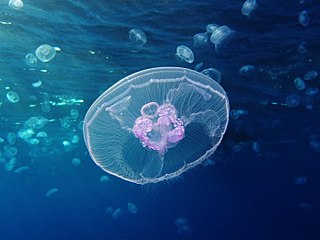
Aurelia is a genus of jellyfish that are commonly called moon jellies, which are in the class Scyphozoa. There are currently 25 accepted species and many that are still not formally described.

Cassiopea andromeda is one of many cnidarian species called the upside-down jellyfish. It usually lives in intertidal sand or mudflats, shallow lagoons, and around mangroves. This jellyfish, often mistaken for a sea anemone, usually keeps its mouth facing upward. Its yellow-brown bell, which has white or pale streaks and spots, pulsates to run water through its arms for respiration and to gather food.

Drymonema is a genus of true jellyfish, placed in its own family, the Drymonematidae. There are three species: Drymonema dalmatinum, Drymonema gorgo, and Drymonema larsoni, which are found in the Gulf of Mexico, Atlantic Ocean and Mediterranean Sea.
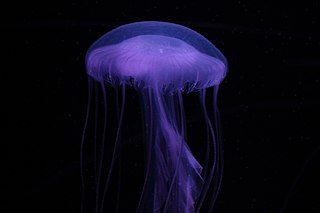
Sanderia is a genus of jellyfish in the family Pelagiidae. There are two species recognized.

Carybdea marsupialis is a venomous species of box jellyfish, in the small family Carybdeidae within the class Cubozoa.

The Enthemonae is a suborder of sea anemones in the order Actiniaria. It comprises those sea anemones with typical arrangement of mesenteries for actiniarians.
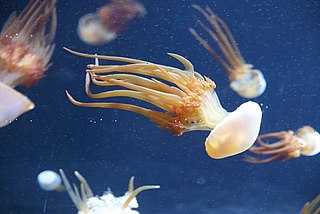
Rhopilema esculentum, the flame jellyfish, is a species of jellyfish native to the warm temperate waters of the Pacific Ocean. It is a popular seafood in southeastern Asia. In the 1980s, research was undertaken in China into its aquaculture, and it is now bred in ponds in that country before being released into the sea to grow to a mature size suitable for the fishery.

Rhopilema verrilli, the mushroom cap jellyfish, is a species of jellyfish in the family Rhizostomatidae. They are cnidarian invertebrates distinguished by their mushroom-shaped medusae. The species does not have any tentacles; however, they still have stinging cells, called nematocysts, within their bells, which can produce mild stings to humans.

The South American sea nettle is a species of jellyfish from the family Pelagiidae. It is found from the Pacific coast of Peru, south along Chile's coast to Tierra del Fuego, and north along the Atlantic coast of Argentina, with a few records from Uruguay. Despite its common name, it is not the only sea nettle in South America. For example, C. lactea is another type of sea nettle in this region. Historically, C. plocamia was often confused with C. hysoscella, a species now known to be restricted to the northeast Atlantic. C. plocamia is a large jellyfish, up to 1 m in bell diameter, although most mature individuals only are 25–40 cm (10–16 in).
Chiropsella bronzie is a species of box jellyfish. It is considered much less of a threat to humans than some of its relatives. The species was described in 2006, and is one of four species in the genus Chiropsella. Chiropsella bronzie can be found in shallow waters off the coast of Queensland, Australia.

Cephea cephea, also known as the crown jellyfish, or cauliflower jellyfish, is a species of jellyfish in the family Cepheidae. It occurs in the tropical waters of the western Indo-Pacific to Northern Australia. The species was first described by Peter Forsskål in 1775 and originally given the name Medusa cephea. It inhabits the pelagic zone of tropical and sub-tropical waters and is most commonly found in the Indo-West Pacific, eastern Atlantic and the Red Sea. Although this species is among the most venomous jellyfish, it is not harmful to humans and is eaten as a delicacy and used for medical purposes in China and Japan. The species can achieve a diameter of up to 60 cm.

















